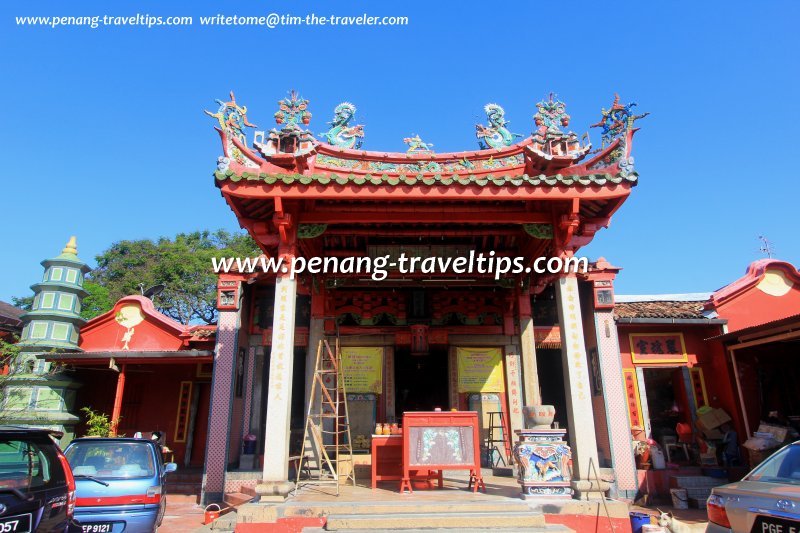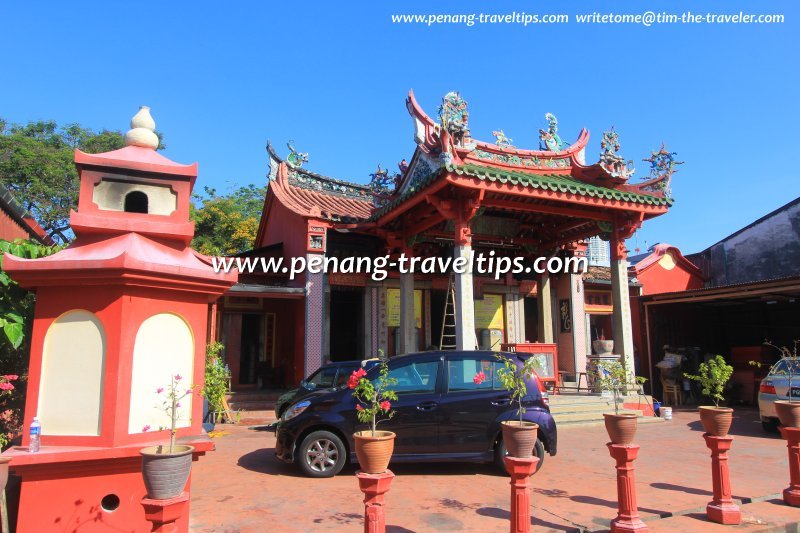 Seng Hong Beow, Bridge Street, George Town, Penang (6 February 2013)
Seng Hong Beow, Bridge Street, George Town, Penang (6 February 2013)
Seng Hong Beow (GPS: 5.40633, 100.3289; Simplified Chinese: 城隍庙, Traditional Chinese: 城隍廟; Pinyin: Chénghuángmiào, Penang Hokkien: Seng3 Hong3 Beo33
 ), also written Seng Ong Beow, or Temple of the City Protector and Chief Magistrate of Hades, is located along Bridge Street, at the junction with Sandilands Street, in the inner city of George Town. The temple is similar in nature to the Seng Wong Beo, the City God Temple, in Singapore, which is famous for its "ghost marriages".
), also written Seng Ong Beow, or Temple of the City Protector and Chief Magistrate of Hades, is located along Bridge Street, at the junction with Sandilands Street, in the inner city of George Town. The temple is similar in nature to the Seng Wong Beo, the City God Temple, in Singapore, which is famous for its "ghost marriages".Seng Hong Beow venerates its namesake deity, Seng Ong, who is the Chief Magistrate of Hades and judge of the afterlife (or underworld). This position makes him the patron of government officers and the police. The Seng Ong is known by the honorific name Dizang Wang Pusa (Traditional Chinese: 地藏王菩薩, Simplified Chinese: 地藏王菩萨). He is the bodhisattva Ksitigarbha (地藏) first mentioned in the Sutra of The Great Vows of Ksitigarbha Bodhisattva, one of the popular sutras of Mahayana Buddhism.
Recently (in 2002), some 300 ancient Taoist manuscripts were uncovered at the Seng Hong Beow by Chinese academician Ong Seng Huat. These manuscripts were said to have been brought from China over a hundred years ago and are believed to be about 400 years old.
 Seng Hong Beow, Bridge Street, George Town (6 February 2013)
Seng Hong Beow, Bridge Street, George Town (6 February 2013)
When Seng Hong Beow was first built, it was surrounded by a mangrove swamp (much of George Town was indeed a mangrove swamp), which has since been cleared and developed. Although Seng Hong Beow is just a small temple within George Town, it was very influential during its heyday, especially to the Hokkien community. The temple has been around since at least 1871, for Khoo Thean Teik, the leader of the Khian Teik Secret Society, had been a benefactor to the temple (for cross reference, read Hock Teik Cheng Sin Temple).
According to Ong Seng Huat, while there could be many temples to the same deity in a town, there could only be one dedicated to Seng Ong, because Seng Ong is the spiritual personification of the town. The site chosen for the temple on the southern part of the Praigin River symbolizes the settlement and expansion of the immigrant Hokkiens.
For the local community, Seng Hong Beow is also known as the "ghost temple". This is due to its mystical function - the venue to exorcise evil spirits and demons that haunt the mangrove swamp on which the new settlement was carved out. It was also where captured demons were kept. At the time Seng Hong Beow was constructed, the sea came right up to its front. At that time, the temple was not built on solid ground, but on a raised platform that bobble according to the tide. Hence, the Seng Hong Beow was also called the "floating lotus on a pond".
 Seng Hong Beow Temple (6 February 2013)
Seng Hong Beow Temple (6 February 2013)
Updates
As of 2013, Seng Hong Beow is undergoing restoration work.How go to go Seng Hong Beow Temple
You can reach Seng Hong Beow by taking Rapid Penang Bus 302 or 401. Alight at the bus stop along McNair Street. From there, walk south on McNair Street until junction of Sandilands Street. Turn left, walk till junction of Sandilands Street with Bridge Street. Turn left and you will see Seng Hong Beow on the left side of Bridge Street.Seng Ong Beow Temple is  on the map of Seven Streets Precinct
on the map of Seven Streets Precinct
List of Chinese Temples in Penang and Chinese Temples in Malaysia

Copyright © 2003-2025 Timothy Tye. All Rights Reserved.

 Go Back
Go Back